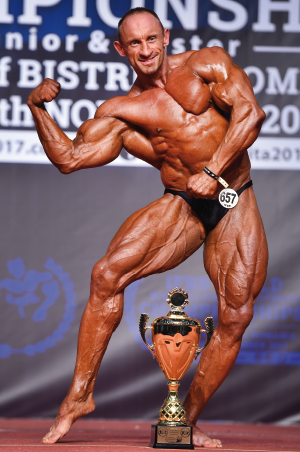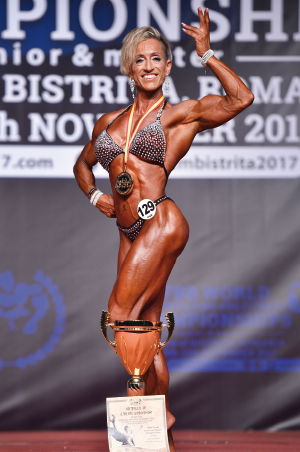Our Disciplines
Men's Bodybuilding:
Athletes train to develop all bodyparts and muscles to maximum size but in balance and harmony. There should be no “weak points” or underdeveloped muscles. Moreover, they should follow a special pre-competition training cycle, to decrease the bodyfat level as low as possible and remove the underskin water to show the quality of muscles: density, separation and definition. Who can display more muscle details is scoring higher at the contest. And the other matter to be assessed is general view of the physique, which should be proportionally built. It means broad shoulders and narrow waist as well as adequately long legs and shorter upper body.
These qualities are displayed during two physique assessment rounds when competitors do 7 mandatory poses during comparisons of 3 to 8 athletes proposed by the judges. Athletes perform barefoot, in posing trunks. There are 7 bodyweight categories for men: 65 kg; 70 kg; 75 kg; 80 kg; 90 kg; 100 kg and over 100 kg.
There is also a routine round when athletes can show their physique during 60-second free posing routine performed to the music of their choice. It is an attractive, artistic presentation, including compulsory and non-compulsory poses and other type of movements. There are three rounds. In each round each panel judge must put the competitors in order, giving them individual places from the first to the last.

Men’s Physique:
In 2012 the Men’s Physique division was officially launched as a new IFBB sport.
It proves to be a very popular category, There are 6 categories in Men’s Physique: 170 cm, 173 cm, 176 cm, 179 cm, 182 cm and over 182 cm. They perform two rounds of quarter turns, wearing board shorts of their choice. The final round (Round 2) begins with a short individual onstage presentation of each competitor.
It is aimed at men who do weight training, keep fit and eat a healthy balanced diet, but who prefer to develop a less muscular, yet athletic and aesthetically pleasing physique.
They are fit looking contestants who display proper shape and symmetry, combined with some muscularity and good overall condition. The athletes should have stage presence and poise and their personality and ability to present themselves onstage with confidence, should be visible.

Men's Classic Bodybuilding:
It is a version of bodybuilding for those male athletes who don’t want to develop their muscles to their “extreme” full potentials but prefer lighter “classic” physique.
To create the equal chances to them, the competitors’ bodyweight is limited according to their body height, following the special IFBB formula for each body height category (currently there are five categories: 168 cm; 171 cm, 175 cm, 180 cm and over 180 cm).
Since muscle mass is limited, special attention is paid to the overall view of the physique, body proportions and lines, muscle shape and condition (density, bodyfat level, definition and details).
These values are assessed by the judges during Rounds 1 and 3. In Round 2, like in bodybuilding, free posing routines are performed to music of athlete’s choice.

Women’s Physique:
This IFBB division was introduced with the beginning of 2013 for women who want to prepare heavier, bodybuilding-style body but not extremely dried, lean and muscular, yet athletic and aesthetically pleasing.
Altogether, there are 3 rounds. In round 1 (semi-finals) competitors’ physiques and muscularity are assessed during quarter turns and four compulsory poses. In the finals compulsory poses and the posedown are performed in round 2 and a short, 30-second posing routine to music of competitor’s choice in round 3.This sport is placed somewhere between Bodyfitness and former Women Bodybuilding which has been removed from the IFBB list of official sports in 2013.
Competitors are expected to present the overall athletic development of the musculature but also balanced and symmetrical development of all muscle groups as well their sport condition and quality, with visible separation between them.
There are two categories in this division: up to 163 cm and over 163 cm.

Women Fitness:
This concept has been introduced by the IFBB in the early 90’s, starting as official competition in 1996 in response to the increasing demand for competitions for women who prefer to develop a less muscular, yet athletic and aesthetically pleasing physique and also to show their physiques in motion. In Women Fitness, the emphasis is placed on a shapely, athleticlooking physique, assessed by comparisons of four quarter turns and athletic ability, assessed during a very attractive and dynamic fitness style routine. Currently, there are two Women’s Fitness categories: up to 163 cm and over 163 cm.
The judges are looking for strengths elements, flexibility movements, high tempo, technical perfection, elegance and grace. Competitors may use small props, associated with their attires.
As it is a physique sport as well, there are also two physique assessment rounds beside this artistic routine rounds. In Round 1 and 3 competitors perform four quarter turns in bikini suit, during which the judges assess their figures and body contours, bodypart shape, bodyfat level, body firmness and muscle tone, overall stage presentation (self-confidence, poise, coordination of movements) as well as the overall style of presentation.
Eliminations (if more than 15 athletes), Round 1 (comparisons in quarter turns) and Round 2 (90-second routine) are performed during the Prejudging. In the finals, the top 6 competitors perform their posing routines once again (Round 3) and then quarter turns (Round 4). The subscores from these two final rounds are summed up to create the total and final places of the competitors.

Women’s Bikini-Fitness:
This category has been introduced in 2011 and is aimed at women who keep their body in shape and eat healthy. Overall body lines, balance and proportions, body tone and healthy appearance are taken into consideration. High-intensity weight training and hard, lean muscles are not necessary. The emphasis is on a well-shaped, fit, healthy and attractive appearance, similar to that of models.
Competitors are assessed in two rounds, wearing a two-piece bikini and highheels. In both rounds, quarter-turns, including front, back and both sides stance, are performed. As well, the final round begins with “I-walking”, which gives each competitor a chance to present her body and her charm on the move.
This competition started with one open class and – due to the extreme popularity – expanded to eight body-height categories nowadays: 158 cm, 160 cm, 162 cm, 164 cm, 166 cm, 169 cm, 172 cm and over 172 cm.

